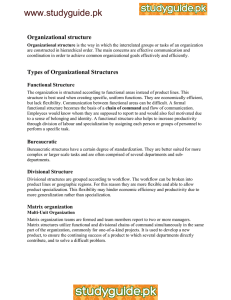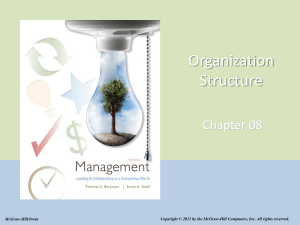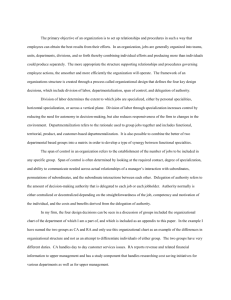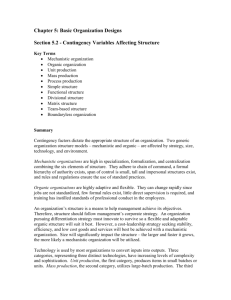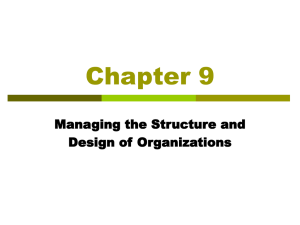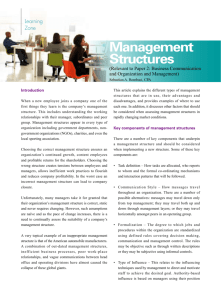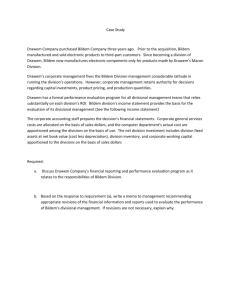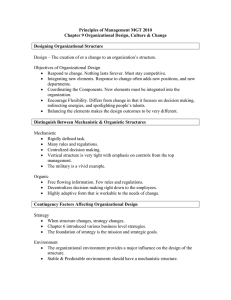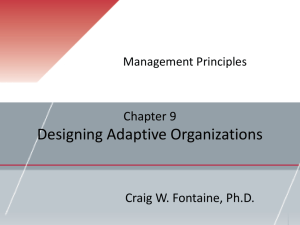Chapter 9: Fundamentals of Organizing
advertisement
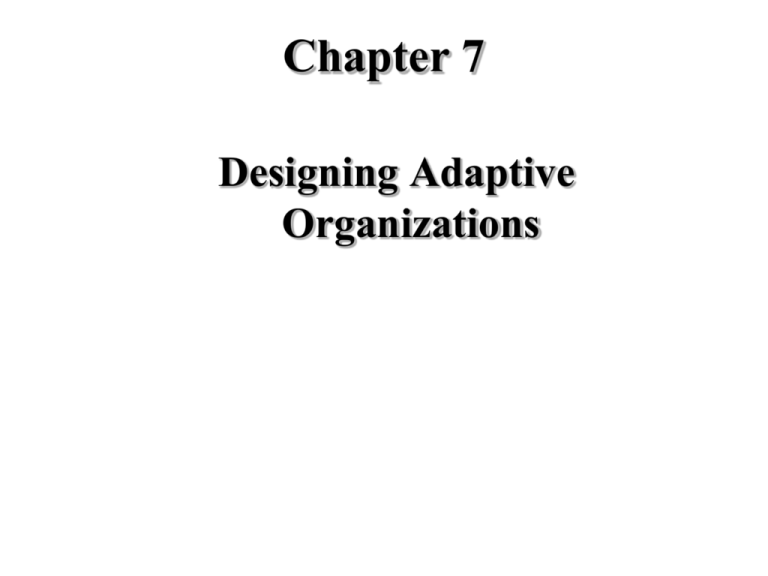
Chapter 7 Designing Adaptive Organizations Major Concerns in Organizing Division of Labor (Differentiation) Coordination (Integration) In Reference to the Organizational Chart, Organizing Involves: VERTICAL STRUCTURE Coordination from Top to Bottom HORIZONTAL STRUCTURE Departmentalization (Who works together?) Work Specialization Degree to which tasks are subdivided into individual jobs A highly specialized job is narrow in scope Increases efficiency up to a point With extreme specialization, workers tend to become bored and alienated Chain of Command The line of authority, shown in the organization chart, that links all persons and shows who reports to whom. CEO VP Marketing VP Production VP Finance Authority Managers have authority because of the positions they hold (not who they are) To be effective, it must be accepted by subordinates. Responsibility Duty to perform the task an employee has been assigned Authority should be commensurate with responsibility. Delegation Process to transfer authority and responsibility to positions below Delegation does not reduce responsibility Benefits both the organization and the individual employee Common Practice is to: CENTRALIZE – – – – (authority at top) Accounting Finance Human Resources Management Information Systems DECENTRALIZE – Production – Marketing (much delegation) Span of Management Number of employees reporting to a supervisor Tradition has recommended a span of management of four to seven subordinates What is best depends on the situation Departmentalization Basis for grouping job positions into departments and departments into the total organization. Internal Operations Oriented – Functional – Network (Virtual) Output Oriented – Divisional » Product » Geographic » Customer – Team (Cluster) Combinations – Hybrid (different types at different places in an org.) – Matrix (different types at simultaneous at the same places in an org.) Functional Approach Departments based on similar activities, skills and resource use. Advantages: Disadvantages: Efficient use of resources Economies of Scale In-depth skill specialization Poor communication among departments Slow response to external changes Loyalty more to function than customer or the whole organization Divisional Approach Departments are grouped together based on organizational outputs (e.g., product, geography, customer) Functions (e.g., marketing) are split among the divisions Its advantages and disadvantages tend to be the opposite of those of the functional approach Divisions Advantages: Disadvantages: Quicker Duplication changes in an unstable environment More in touch with customers – Competition for resources among divisions – More managers needed Less professional specialization Matrix Approach Functional and divisional chains of command simultaneously Violates the unity of command concept. Matrix Structure - Why? To get the advantages of both Functional and Divisional Structures Sophisticated technology, fast-changing environment Diverse products and geographical areas Disadvantages of Matrix Many meetings to coordinate activities High conflict between two sides of matrix Need for extensive human relations training Team Approach Cross-functional teams (Clusters) consist of employees from various functional departments Teams typically have more decision making power than previously held by workers at their levels. Team Approach Advantages – Quicker response time – Better morale – Reduced administrative overhead Disadvantages – Conflict – Time and resources spent on meetings Network (Virtual) Approach Organization divides major functions among separate companies brokered by a small headquarters organization Somewhat like a functional organization. Network Approach Advantages – Increases competitiveness, especially of small firms – Flexibility – Reduced Costs Disadvantages – No hands-on control – Loyalty weakened. Mechanistic vs. Organic Organizations Vertical vs. Horizontal Structural Dominance Rigid vs. Flexible Specialized Jobs vs. Unspecialized Boss Control vs. Self-Control Centralized Decisions vs. Decentralized Bureaucratic vs. Non-bureaucratic Departmentalization Types (From most Mechanistic to most Organic) Functional Functional with integrators, crossfunctional committees, etc. Matrix Divisional Team When the Mechanistic (Vertical) Approach is most Appropriate: External Environment is: Stable Growth and Innovation Goals are: Few or Nonexistent (Internal Stability) The Organization’s Size is: Large The Technology is: Mass Production (or involving low-level skills) When the OrganicApproach is most Appropriate: External Environment is: Unstable Growth and Innovation Goals are: Numerous Technology is: Small Batch Continuous Process Flexible Manufacturing (Computer Assisted) Service, especially professional service jobs. Service Technology Tends to be more Organic (Horizontal) than manufacturing Employees have direct contact with customers Output of the firm is intangible Production and consumption are simultaneous
